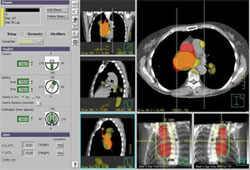
CVMC Dosimetrist Ellen Thompson, CMD, RT(T) works in conjunction with the radiation oncologist and medical physicist to determine the treatment location, beam arrangement and dose distribution required to treat the patient.
Once the treatment area has been identified and recorded with CT imaging, the oncology team begins work on analyzing this data in order to determine the most accurate treatment plan for each patient.
This treatment planning process requires that a medical physicist and a dosimetrist work in conjunction with the radiation oncologist to determine the optimal beam energies, number of treatment fields, beam entry angles, and resultant dose distribution required to deliver the most effective treatment for each patient.
Extensive work using three dimensional computer simulation technology is done in order to generate multiple treatment options for the tumor site. The radiation oncologist then carefully individualizes a treatment plan for each patient. The radiation oncologist determines the total radiation dose to the tumor and the total number of treatments required for the patient.
 Specially designed blocking devices are also made based on data obtained during the simulation phase. During IMRT, these blocking devices divide the radiation beam into tiny beamlets of varying intensity so the radiation dose can be made to “modulate” around normal tissues.
Specially designed blocking devices are also made based on data obtained during the simulation phase. During IMRT, these blocking devices divide the radiation beam into tiny beamlets of varying intensity so the radiation dose can be made to “modulate” around normal tissues.

